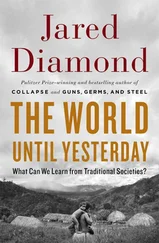Jared Diamond - Guns, Germs & Steel
Здесь есть возможность читать онлайн «Jared Diamond - Guns, Germs & Steel» весь текст электронной книги совершенно бесплатно (целиком полную версию без сокращений). В некоторых случаях можно слушать аудио, скачать через торрент в формате fb2 и присутствует краткое содержание. Жанр: 105. Описание произведения, (предисловие) а так же отзывы посетителей доступны на портале библиотеки ЛибКат.
- Название:Guns, Germs & Steel
- Автор:
- Жанр:
- Год:неизвестен
- ISBN:нет данных
- Рейтинг книги:5 / 5. Голосов: 1
-
Избранное:Добавить в избранное
- Отзывы:
-
Ваша оценка:
- 100
- 1
- 2
- 3
- 4
- 5
Guns, Germs & Steel: краткое содержание, описание и аннотация
Предлагаем к чтению аннотацию, описание, краткое содержание или предисловие (зависит от того, что написал сам автор книги «Guns, Germs & Steel»). Если вы не нашли необходимую информацию о книге — напишите в комментариях, мы постараемся отыскать её.
Guns, Germs & Steel — читать онлайн бесплатно полную книгу (весь текст) целиком
Ниже представлен текст книги, разбитый по страницам. Система сохранения места последней прочитанной страницы, позволяет с удобством читать онлайн бесплатно книгу «Guns, Germs & Steel», без необходимости каждый раз заново искать на чём Вы остановились. Поставьте закладку, и сможете в любой момент перейти на страницу, на которой закончили чтение.
Интервал:
Закладка:
30 • PROLOGUE
(Chapter 12). Writing has evolved de novo only a few times in human history, in areas that had been the earliest sites of the rise of food production in their respective regions. All other societies that have become literate did so by the diffusion of writing systems or of the idea of writing from one of those few primary centers. Hence, for the student of world history, the phenomenon of writing is particularly useful for exploring another important constellation of causes: geography's effect on the ease with which ideas and inventions spread.
What holds for writing also holds for technology (Chapter 13). A crucial question is whether technological innovation is so dependent on rare inventor-geniuses, and on many idiosyncratic cultural factors, as to defy an understanding of world patterns. In fact, we shall see that, paradoxically, this large number of cultural factors makes it easier, not harder, to understand world patterns of technology. By enabling farmers to generate food surpluses, food production permitted farming societies to support full-time craft specialists who did not grow their own food and who developed technologies.
Besides sustaining scribes and inventors, food production also enabled farmers to support politicians (Chapter 14). Mobile bands of hunter-gatherers are relatively egalitarian, and their political sphere is confined to the band's own territory and to shifting alliances with neighboring bands. With the rise of dense, sedentary, food-producing populations came the rise of chiefs, kings, and bureaucrats. Such bureaucracies were essential not only to governing large and populous domains but also to maintaining standing armies, sending out fleets of exploration, and organizing wars of conquest.
Part 4 ("Around the World in Five Chapters," Chapters 15-19) applies the lessons of Parts 2 and 3 to each of the continents and some important islands. Chapter 15 examines the history of Australia itself, and of the large island of New Guinea, formerly joined to Australia in a single continent. The case of Australia, home to the recent human societies with the simplest technologies, and the sole continent where food production did not develop indigenously, poses a critical test of theories about intercontinental differences in human societies. We shall see why Aboriginal Australians remained hunter-gatherers, even while most peoples of neighboring New Guinea became food producers.
Chapters 16 and 17 integrate developments in Australia and New Guinea into the perspective of the whole region encompassing the East
YAM'S QUESTION "31
Asian mainland and Pacific islands. The rise of food production in China spawned several great prehistoric movements of human populations, or of cultural traits, or of both. One of those movements, within China itself, created the political and cultural phenomenon of China as we know it today. Another resulted in a replacement, throughout almost the whole of tropical Southeast Asia, of indigenous hunter-gatherers by farmers of ultimately South Chinese origin. Still another, the Austronesian expansion, similarly replaced the indigenous hunter-gatherers of the Philippines and Indonesia and spread out to the most remote islands of Polynesia, but was unable to colonize Australia and most of New Guinea. To the student of world history, all those collisions among East Asian and Pacific peoples are doubly important: they formed the countries where one-third of the modern world's population lives, and in which economic power is increasingly becoming concentrated; and they furnish especially clear models for understanding the histories of peoples elsewhere in the world.
Chapter 18 returns to the problem introduced in Chapter 3, the collision between European and Native American peoples. A summary of the last 13,000 years of New World and western Eurasian history makes clear how Europe's conquest of the Americas was merely the culmination of two long and mostly separate historical trajectories. The differences between those trajectories were stamped by continental differences in domesticable plants and animals, germs, times of settlement, orientation of continental axes, and ecological barriers.
Finally, the history of sub-Saharan Africa (Chapter 19) offers striking similarities as well as contrasts with New World history. The same factors that molded Europeans' encounters with Africans molded their encounters with Native Americans as well. But Africa also differed from the Americas in all these factors. As a result, European conquest did not create widespread or lasting European settlement of sub-Saharan Africa, except in the far south. Of more lasting significance was a large-scale population shift within Africa itself, the Bantu expansion. It proves to have been triggered by many of the same causes that played themselves out at Cajamarca, in East Asia, on Pacific islands, and in Australia and New Guinea.
I harbor no illusions that these chapters have succeeded in explaining the histories of all the continents for the past 13,000 years. Obviously, that would be impossible to accomplish in a single book even if we did understand all the answers, which we don't. At best, this book identifies several constellations of environmental factors that I believe provide a large part
3 2 ' PROLOGUE
of the answer to Yali's question. Recognition of those factors emphasizes the unexplained residue, whose understanding will be a task for the future.
The Epilogue, entitled "The Future of Human History as a Science," lays out some pieces of the residue, including the problem of the differences between different parts of Eurasia, the role of cultural factors unrelated to environment, and the role of individuals. Perhaps the biggest of these unsolved problems is to establish human history as a historical science, on a par with recognized historical sciences such as evolutionary biology, geology, and climatology. The study of human history does pose real difficulties, but those recognized historical sciences encounter some of the same challenges. Hence the methods developed in some of these other fields may also prove useful in the field of human history.
Already, though, I hope to have convinced you, the reader, that history is not "just one damn fact after another," as a cynic put it. There really are broad patterns to history, and the search for their explanation is as productive as it is fascinating.
PART ONE
FROM EDEN TO CAJAMARCA
54 ' GUNS, GERMS, AND STEEL
toms and we caught all the people. Not one escaped. Some ran away from us, these we killed, and others we killed—but what of that? It was in accordance with our custom."
The brutal outcome of this collision between the Moriori and the Maori could have been easily predicted. The Moriori were a small, isolated population of hunter-gatherers, equipped with only the simplest technology and weapons, entirely inexperienced at war, and lacking strong leadership or organization. The Maori invaders (from New Zealand's North Island) came from a dense population of farmers chronically engaged in ferocious wars, equipped with more-advanced technology and weapons, and operating under strong leadership. Of course, when the two groups finally came into contact, it was the Maori who slaughtered the Moriori, not vice versa.
The tragedy of the Moriori resembles many other such tragedies in both the modern and the ancient world, pitting numerous well-equipped people against few ill-equipped opponents. What makes the Maori-Moriori collision grimly illuminating is that both groups had diverged from a common origin less than a millennium earlier. Both were Polynesian peoples. The modern Maori are descendants of Polynesian farmers who colonized New Zealand around a.d. 1000. Soon thereafter, a group of those Maori in turn colonized the Chatham Islands and became the Moriori. In the centuries after the two groups separated, they evolved in opposite directions, the North Island Maori developing more-complex and the Moriori less-complex technology and political organization. The Moriori reverted to being hunter-gatherers, while the North Island Maori turned to more intensive farming.
Those opposite evolutionary courses sealed the outcome of their eventual collision. If we could understand the reasons for the disparate development of those two island societies, we might have a model for understanding the broader question of differing developments on the continents.
mloriori and maori history constitutes a brief, small-scale natural experiment that tests how environments affect human societies. Before you read a whole book examining environmental effects on a very large scale-1-effects on human societies around the world for the last 13,000 years— you might reasonably want assurance, from smaller tests, that such effects
Интервал:
Закладка:
Похожие книги на «Guns, Germs & Steel»
Представляем Вашему вниманию похожие книги на «Guns, Germs & Steel» списком для выбора. Мы отобрали схожую по названию и смыслу литературу в надежде предоставить читателям больше вариантов отыскать новые, интересные, ещё непрочитанные произведения.
Обсуждение, отзывы о книге «Guns, Germs & Steel» и просто собственные мнения читателей. Оставьте ваши комментарии, напишите, что Вы думаете о произведении, его смысле или главных героях. Укажите что конкретно понравилось, а что нет, и почему Вы так считаете.










